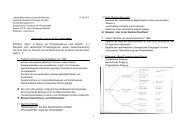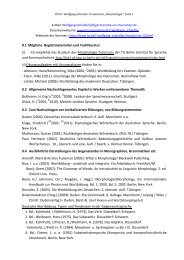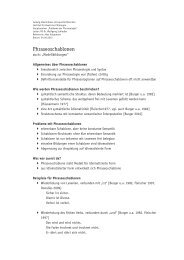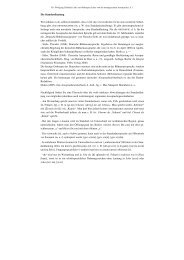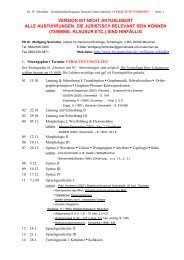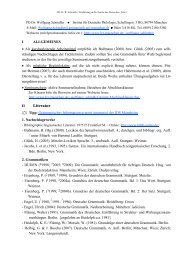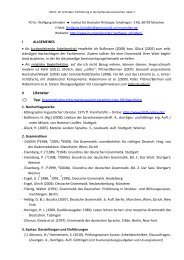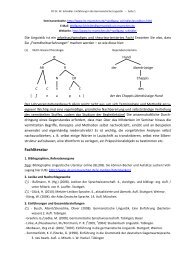Chapter 18 Lexical Functions: Description of Lexical Relations in a ...
Chapter 18 Lexical Functions: Description of Lexical Relations in a ...
Chapter 18 Lexical Functions: Description of Lexical Relations in a ...
Create successful ePaper yourself
Turn your PDF publications into a flip-book with our unique Google optimized e-Paper software.
6.1.5 LFs as Deep <strong>Lexical</strong> Units<br />
—<strong>Chapter</strong> <strong>18</strong>. <strong>Lexical</strong> <strong>Functions</strong>— 85<br />
Summ<strong>in</strong>g up what has just been said, simple standard LFs are, <strong>in</strong> an important respect,<br />
similar to grammatical signifieds—<strong>in</strong>flectional (= grammemes), such as nom<strong>in</strong>al number or<br />
verbal tense, or derivational (= derivatemes), such as Agent or Location nouns. Namely, very<br />
much like grammatical signifieds, LFs are not genu<strong>in</strong>e, bona fide mean<strong>in</strong>gs. For <strong>in</strong>stance, the<br />
grammeme (PLURAL) is a label for a set <strong>of</strong> correspondences between a few mean<strong>in</strong>gs—(more than<br />
one) (trees), or (different sorts <strong>of</strong>) (French w<strong>in</strong>es), or else (great quantity/extent)(the sands <strong>of</strong> the<br />
desert)—and a few morphological markers—-s, -en (oxen), -i (foci), -a (phenomena), etc. In just<br />
the same way, the LF f is a label for a cluster <strong>of</strong> correspondences between several related mean-<br />
<strong>in</strong>gs (= hav<strong>in</strong>g a common core) and several lexical expressions. Therefore, a complete description<br />
<strong>of</strong> an LF must <strong>in</strong>clude all its alternative semantic representations (which is not done <strong>in</strong> the list <strong>in</strong><br />
Subsection 2.2). In order to give an idea <strong>of</strong> what this could look like, let me give three examples.<br />
NB : The underscor<strong>in</strong>g <strong>in</strong> a SemS <strong>in</strong>dicates the semantically dom<strong>in</strong>ant node: a node <strong>in</strong> the assertional<br />
part <strong>of</strong> it which resumes, <strong>in</strong> a sense, the whole SemS; the rest <strong>of</strong> the SemS h<strong>in</strong>ges, so to speak, on the<br />
dom<strong>in</strong>ant node, so that a SemS is reducible to its dom<strong>in</strong>ant node. 24 ]<br />
1. The LF S 1:<br />
LF-Sem-Rule 1<br />
2. The LF Magn:<br />
LF-Sem-Rule 2<br />
2<br />
(P) # (magnitude )<br />
(P)<br />
1<br />
(person)<br />
(very)<br />
1<br />
(!)<br />
!<br />
"<br />
S (L(P))<br />
1<br />
L(P)<br />
ATTR<br />
Magn<br />
The mean<strong>in</strong>g (person who P-es) can be<br />
expressed by a derived noun S 1, some-<br />
th<strong>in</strong>g <strong>of</strong> the type P-er (smoker, skier,<br />
student, blacksmith, etc.).<br />
The mean<strong>in</strong>g (value a <strong>of</strong> magnitude P<br />
is elevated) can be expressed by a<br />
Magn, modify<strong>in</strong>g the noun L(P) that<br />
lexicalizes the mean<strong>in</strong>g (P).


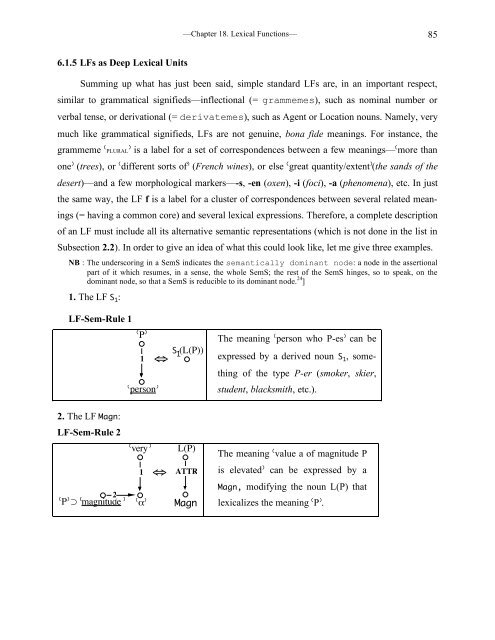
![E-Mail: Wolfgang.Schindler[ätt]germanistik.uni-muenchen.de Web ...](https://img.yumpu.com/51590147/1/184x260/e-mail-wolfgangschindlerattgermanistikuni-muenchende-web-.jpg?quality=85)
